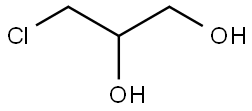
2,3-DICHLORO-1-PROPANOL synthesis
- Product Name:2,3-DICHLORO-1-PROPANOL
- CAS Number:616-23-9
- Molecular formula:C3H6Cl2O
- Molecular Weight:128.99

56-81-5
1771 suppliers
$5.00/25g

616-23-9
153 suppliers
$39.50/5g
Yield:616-23-9 88.2%
Reaction Conditions:
with hydrogenchloride;Adipic acid in water at 105; for 10 h;Reagent/catalyst;Temperature;Concentration;
Steps:
2.1 Example 2
1. Glycerol synthesis of epichlorohydrin by chlorination and cyclization reaction composition. Firstly, the influence factors of dichlorohydrin were determined by orthogonal test of four factors and three levels. The effects of hydrogen chloride dosage, catalyst dosage, reaction temperature and reaction time were weakened in turn, then the single factor experiment was used to determine the optimum conditions .The optimum conditions were as follows: mole ratio of hydrogen chloride to glycerol: 1: 23, the dosage of glacial acetic acid was 10%, reaction temperature was 100 °C, the reaction time was 2 h, the reaction time was 2 h, 10h, the mole ratio of hydrogen chloride and glycerol: 1: 23, the dosage of adipic acid 10%, reaction temperature 105 , reaction time 10h, acetic acid and adipic acid as catalysts, the yield of dichloropropanol was the highest Respectively 87.5%, 88.2%.According to the catalyst performance comparison, it is preferred that adipic acid is the catalyst for the chlorination reaction, and the optimum synthesis process is the molar ratio of hydrogen chloride to glycerol:4, the dosage of adipic acid was 10%, the reaction temperature was 105 , the reaction time was 10h, the yield of dichloropropanol was 88.2%.
References:
Huaian Chemical New Material Research Center, Dalian Institute of Chemical Physics, Chinese Academy of Sciences;Zhou, Lijuan;Chen, Jin;Wang, Qing CN105566253, 2016, A Location in patent:Paragraph 0017

56-81-5
1771 suppliers
$5.00/25g

616-23-9
153 suppliers
$39.50/5g

497-04-1
80 suppliers
$60.00/25 mg

96-23-1
282 suppliers
$10.00/1g

96-24-2
303 suppliers
$11.00/5g

56-81-5
1771 suppliers
$5.00/25g

616-23-9
153 suppliers
$39.50/5g

96-23-1
282 suppliers
$10.00/1g

96-24-2
303 suppliers
$11.00/5g

107-18-6
0 suppliers
$24.60/100ml

616-23-9
153 suppliers
$39.50/5g